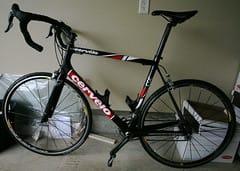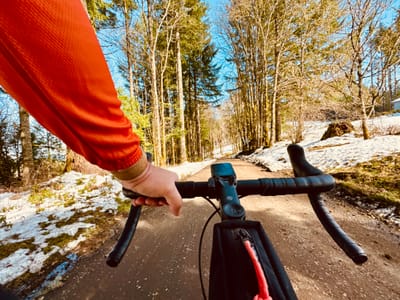Does a $5,000 bike improve an amateur cyclist's performance?

If you've ever spent much time around cyclists, you've certainly noticed they love to talk gear and if you've ever picked up a bike magazine, you've been inundated with ads extolling the virtues of bike performance. It's nearly impossible to separate the marketing fluff from facts whenever doing research on a new bike purchase, given that most publications (both online and off) publishing reviews also take advertising from the companies behind the products. While researching a possible new high-end road bike purchase (I'm riding a 500 mile, week-long event at the end of the summer and thought shaving 3-4lbs off my bike would be nice), I came across the Competitive Cyclist website and I spotted something novel: they offer pro-level bike rentals/demos shipped directly to you for a week.
I immediately recognized the brilliance of a demo program like this -- while magazines and website reviews can all sound the same ("vertically compliant while laterally stiff"), the proof is in the pavement. A week of riding roads I'm familiar with would be a lot more informative than the common 10 minute test ride around a bike shop. I wanted to know what a $5,000 road bike with "crisp, tight handling" and also with "forgiving ride characteristics" felt like on the same roads I ride several hundred miles every year (which I typically do on a $1700 "recreational" aluminum frame/carbon fork Lemond). And more to the point: for an average recreational cyclist like me (60-80 miles ridden on a good week, in the 16-17mph avg speed range), does a $5,000 bike really improve your speed all that much?
I decided to experiment with myself and pony up the $300 to rent a bike for one week (the $300 can be applied to a new purchase if I buy it in the next month). I specified the size I needed, put in my details and a week later, it showed up at my door. Assembly was very easy, just throwing the wheels on, airing up the tires, and putting the bars on the stem. A few adjustments and the addition of my own pedals and it was ready to ride. A quick jump on the bathroom scale holding my old bike showed it was 21.0 pounds with pedals (no water bottle or bag), while the Cervelo with my pedals attached was just 17.4 pounds for the 61cm bike (their largest frame). 3.6 pounds is a pretty significant weight savings for road bikes.
The hyperbole around this specific Cervelo model is that it's really stiff, really light, but also forgiving on the roads, with a more comfortable ride than similar carbon race bikes. From the moment I got on it, I could feel that it was much more responsive. On the same road loops I've been riding for the past few years, I was surprised by how the bike seemed to lurch forward whenever I put a little extra effort on hill climbs. I never thought of my regular bike as inefficient, but you push down on the R3 and it really goes. The handling was great as well -- my typical ride features a couple high-speed tight turns that make me nervous on my regular bike but the Cervelo tracked them tighter and easier than I've ever done them before.
Results
I spent a week on the bike, riding a little over 100 miles on five rides total. Since I wanted to compare rides on this bike versus my previous bike, I did the exact same distances I rode regularly: a 5 mile short fast loop (~13min), a 15 mile loop (~50min), a 27 mile loop (~90-100min), and a 35 mile loop (~2hrs). I have some data on each ride (1, 2, 3), all done in the last couple weeks and some with data going back two years. I've been on a steady schedule the last month or so, and I took the fastest ride time I ever did on my old bike, vs. one ride on the same distance on the Cervelo. Here are the results:
//spreadsheets.google.com/pub?key=pW9Xk03IKGTJvX7tnLQMkbg&output=html&gid=0&single=true&range=A2:E8
The results appear to be pretty consistent with one outlying sample, but since this isn't a real experiment and I couldn't eliminate all possible variables I should say that the variability in improvement is largely due to how much rest I got between rides. On the shortest 5 mile ride, I did it a day after a long ride, and I usually take a day of rest (with rest, it'd be another 30 seconds faster). Wind and weather affected the 15 and 27 mile rides each time I went out on the demo bike, further slowing me down. The longest ride on the demo bike was my strongest ride to date -- I slept an amazing 10 hours the night before and the winds were surprisingly calm. The previous 35 mile slower ride I'm comparing it to was the first time I did it alone and I rode it very conservatively.
More importantly than the % improvement in my ride times, I did consistently ride faster, in the 17-18mph range on most rides, while the past few years of riding have always had me stuck in the 16-17mph average. My training goals have been to eventually work my way up to consistent rides in the 18-20mph average range. Moving up 0.5-1.5 mile an hour of average speed over an hour of riding on the demo bike was no small feat, taking me months of regular training in the past, and I've never been able to do a ride over an hour long in the 18mph range until that demo bike ride.
Bottom Line
The obvious question is whether or not going from a $1,500 average aluminum bike to a $5,000 handcrafted carbon bike is worth the added expense. For some people, shaving seconds off your time is a worthy goal while I would suspect most recreational athletes might want to see 10%-25% time/speed improvements on common workouts. I only found mild performance improvements on my own rides, on the order of single-digit percentage increases in speed and decreases in ride times. It's definitely tough to justify spending 2-3x the amount of money without getting huge changes.
My hope with this test was to prove to myself that magazines and websites and all the bike geek talk was for naught. As much as I love reading about all the latest gadgets in the cycling world, I've long been skeptical about their actual utility and I wanted some data to back it up. In this test I expected to see negligible gains, I expected a rough ride on a stiff frame, and I expected to conclude that $5,000 bikes are generally a waste of money for all but the top athletes. I wanted to free myself from the feeling that I had to constantly upgrade every year to the latest, lightest parts available.
The one thing I can't deny was the incredible feel of the Cervelo R3 when compared to any other bike I've ever ridden. After spending 25 years of my life on BMX and mountain bikes, the first time I took a spin on a road bike I fell in love with the feeling of raw power, blinding speed, and perfect efficiency. I bought my first road bike because it felt like there was nothing standing in between my legs pushing down in some effort and wheels spinning me forward at speeds I'd never attained on flat ground before. When I got up out of the saddle on my first climb with the R3, that same miraculous feeling again washed over me. Here was a new level of efficiency, a perfect melding of body and machine, with not an ounce of wasted effort going towards coasting down the road as fast as possible. The Cervelo R3 simply doesn't hold you back, transmitting every ounce of your effort into progress on the road.
In the end, I'll admit the $5,000 bike won me over on feel more than performance, though the gains weren't too shabby. I attained speeds I've never ridden at before and I suspect if I owned a similar bike that I'd continue to improve and attain levels I couldn't do with my old bike. But more importantly everything about riding felt better on the high end machine. Shifting was instant and precise, climbing hills was faster and easier, and I had more control and could take tight turns at faster speeds. After my 18+mph two hour long ride was over, I felt like I could turn around and ride another 35 miles at that pace and I decided then and there that I'd bite the bullet and purchase a high-end road bike. I eventually settled on a Cervelo RS, a slightly cheaper version of the R3 with a better fit for taller riders like me. At this moment, it's on a UPS truck headed this way, showing up sometime next week.
Subscribe to get new posts in your inbox





